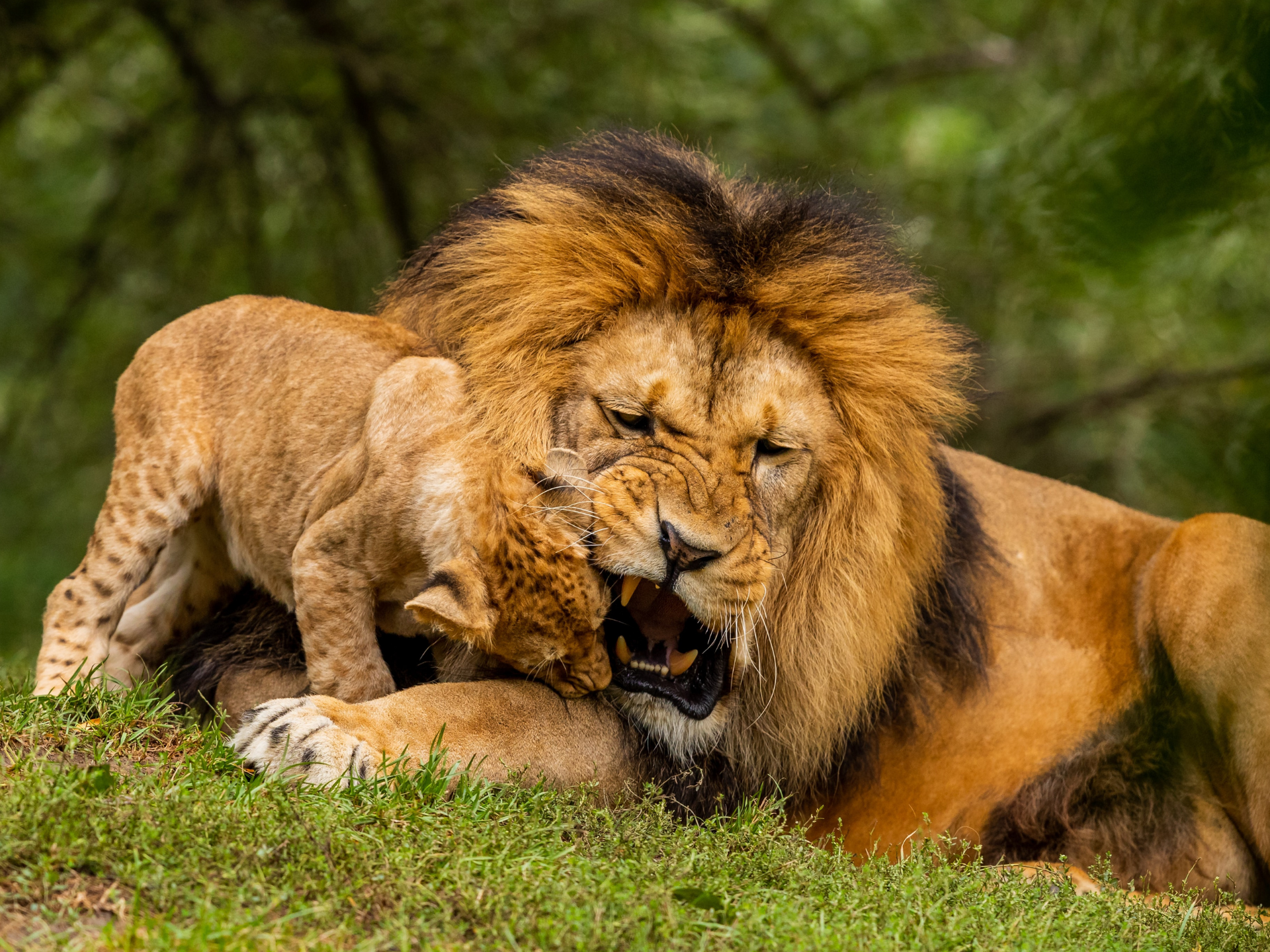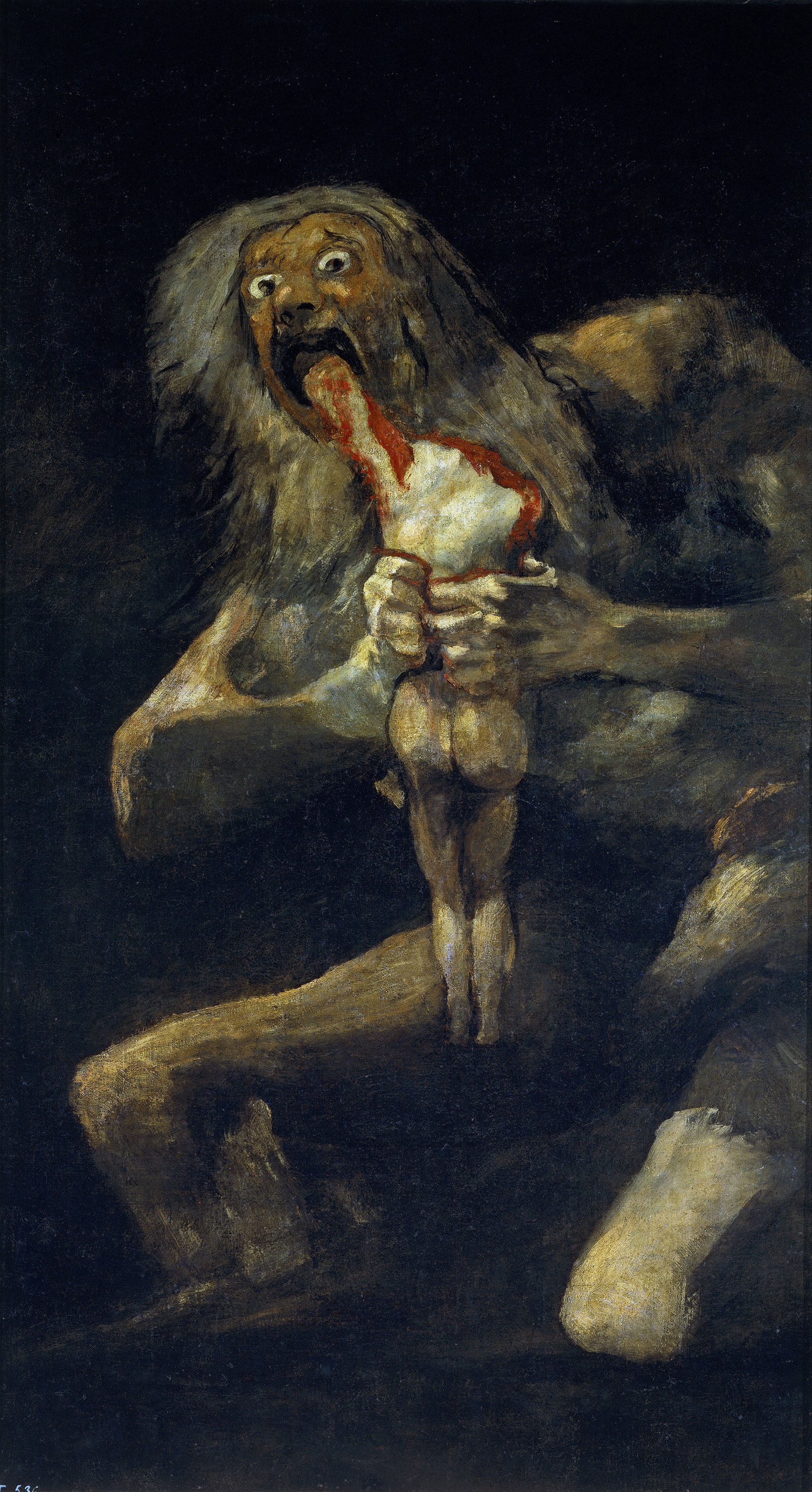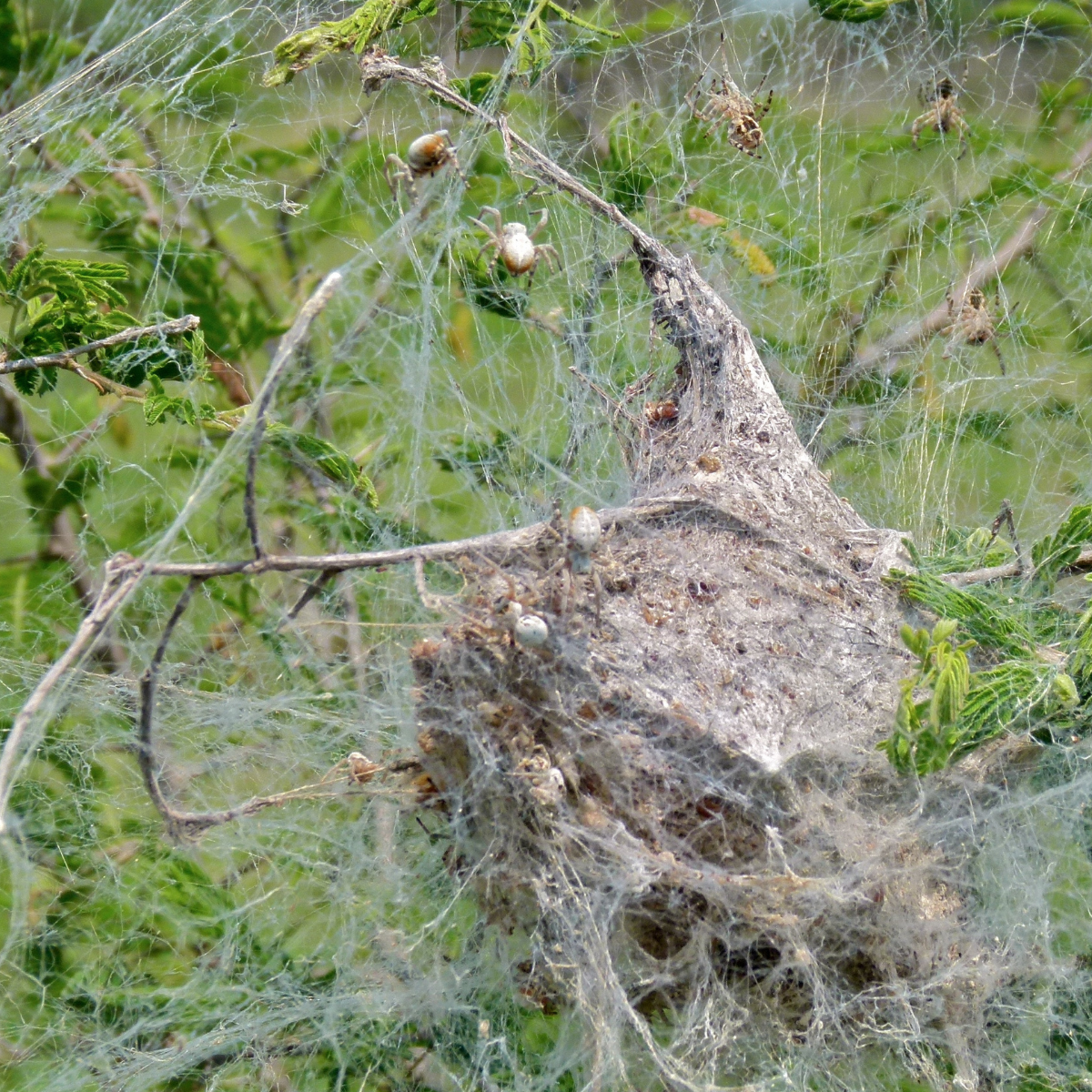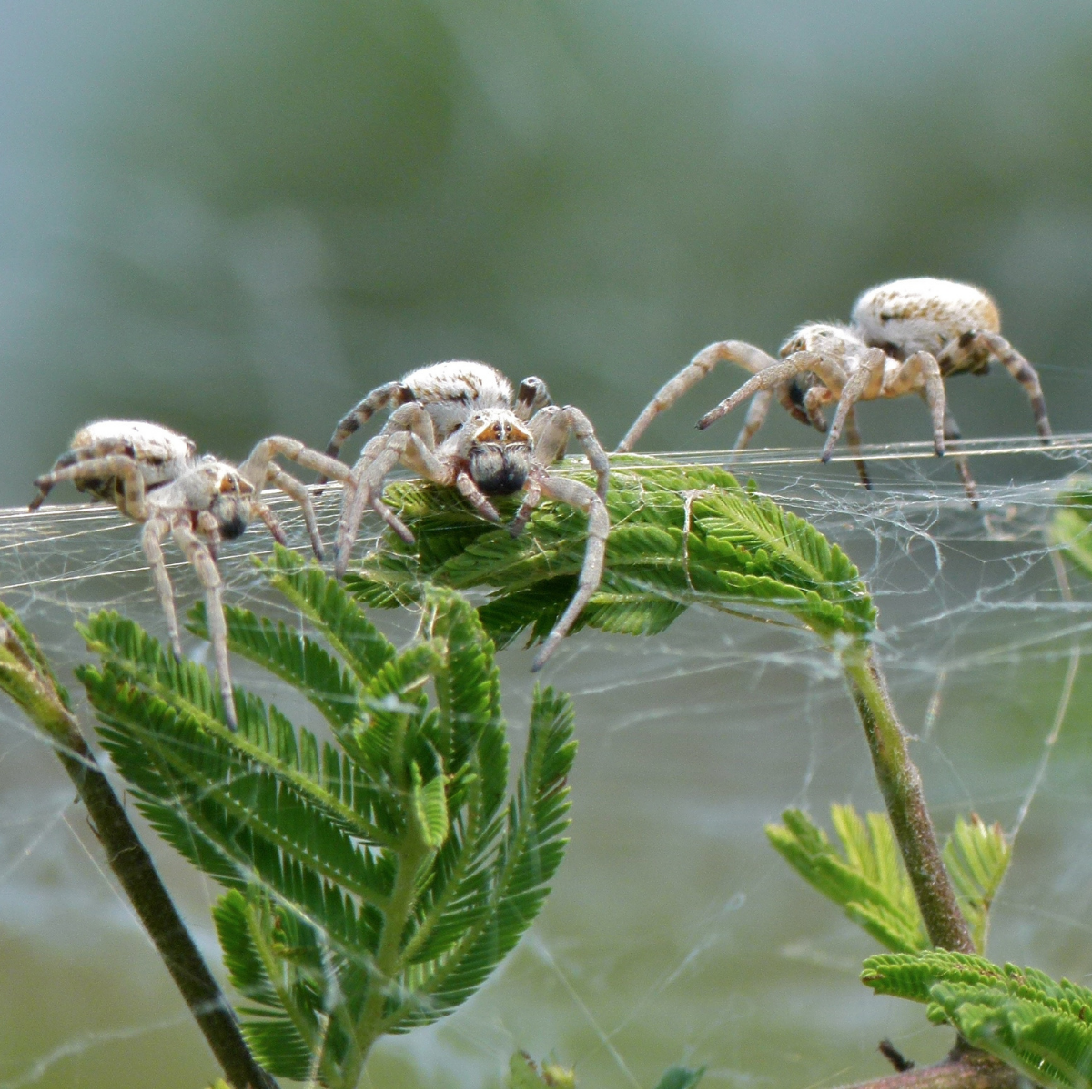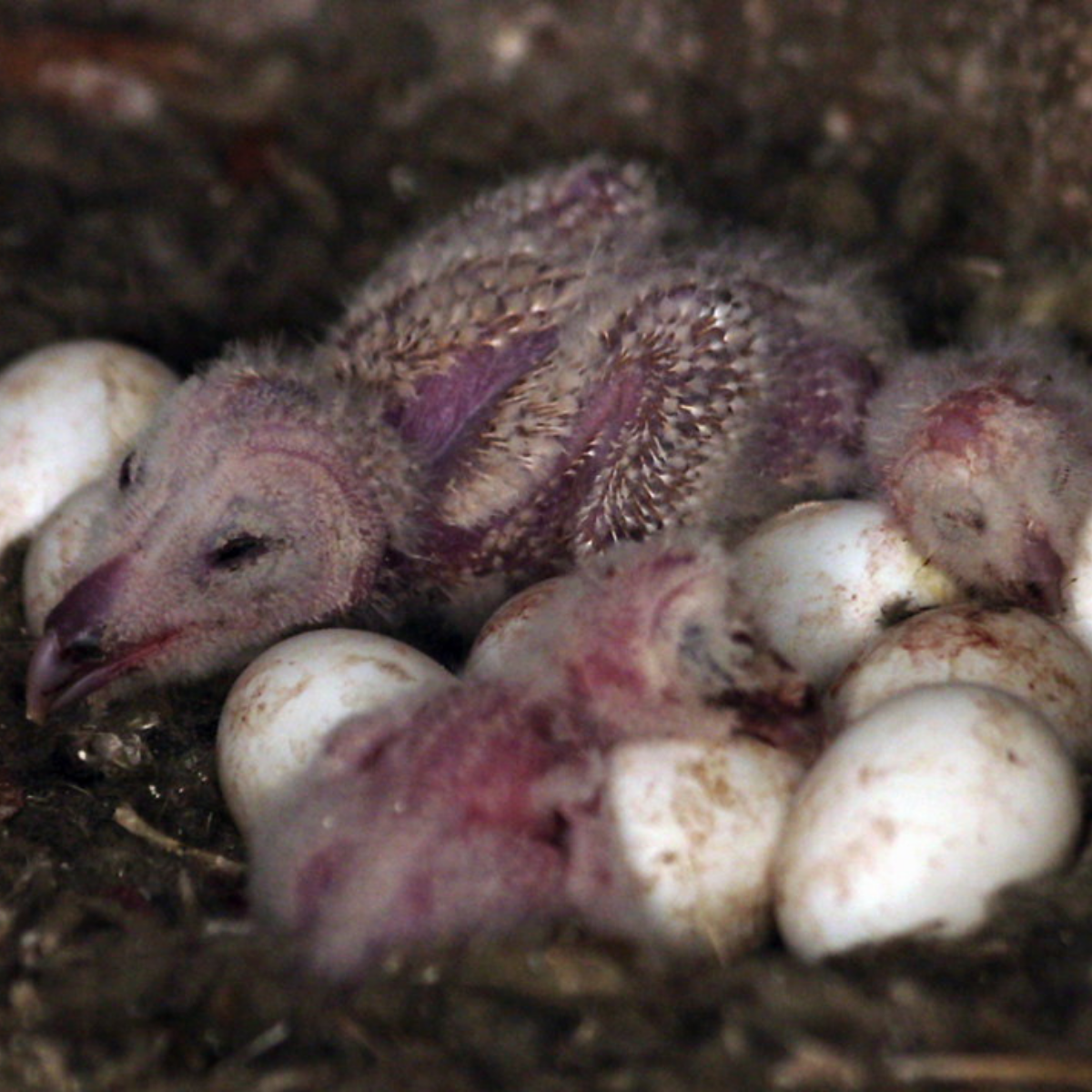Family dinners: when relatives are on the menu
"Click here to listen to the full podcast episode"
Birds do it. Bees do it. We even have evidence that fleas do it, although whether or not those fleas are educated remains to be determined. And by ‘it’, I of course mean cannibalism.
Costs of cannibalism
Birds do it, bees do it, even gods do it
Painting of Saturn devouring his son by Francisco Goya.
Cannibalism is a behaviour that captures the imagination, from tragic tales of desperate sailors marooned at sea to horror stories like Hannibal Lecter in Silence of the Lambs. In western societies, human cannibalism is the ultimate taboo, and there’s good reason for that; cannibalism comes with a lot of costs.
If you want to eat someone, you’ve usually got to kill them first. And killing someone is a risky business. Just don’t ask me how I know. It takes a lot of physical energy and there’s a very strong chance that your victim will fight back and you might get injured as a result, perhaps even killed yourself. And this all takes time, time that could otherwise be spent finding another food source, perhaps one with a little less kick.
Although cannibalism may be taboo for us, that’s not always the case around the world. For the Fore people of Papua New Guinea, cooking and eating the bodies of people who had recently died used to be an act of great respect, allowing the positive aspects of that individual to remain within the tribe and helping to free the spirit of the dead. Far better for your body to be eaten by the people who loved you than eaten by maggots and worms.
But anthropologists who observed the Fore people in the 1950s documented an unusual disease called kuru that was killing up to 2% of the population every year. After ruling out toxic contaminants and genetic illnesses, researchers realised it was a disease spread by eating the brain tissue of affected people, caused by an infectious prion similar to Creutzfeldt-Jakob Disease or mad cow disease.
Disease is a powerful force in evolution, and as it’s much easier to become infected with something nasty by eating an individual of your own species than a different species, this should make it much harder for cannibalistic behaviours to evolve.
For a long time many biologists thought cannibalism was rare in nature because of all these costs; the risk of disease or injury. Plus if adaptations have to be “for the benefit of the species”, eating members of your own species doesn’t seem to fit the bill. Surely, they thought, any cannibalism they saw must be a last resort, an act of extreme starvation. But the more they looked, the more they saw that cannibalism is actually very common in nature.
In the field of evolutionary biology - that’s the science of why and how things evolve - we’ve largely dispensed with the idea of things evolving “for the good of the species”. Instead, for a behaviour to evolve, it must benefit the genes encoding that behaviour, in the context of the environment in which they find themselves. To use very anthropomorphic language, these genes selfishly “want” to put as many copies of themselves into the next generation as possible, regardless of what happens to anyone else, hence the term ‘the selfish gene’.
From this point of view, animals eating members of their own species that they don’t share many genes with makes a bit more sense. But often they’re not just eating any old members of their own species, but members of their own family - in other words, individuals who also share their supposedly ‘selfish’ genes.That’s right, mothers, brothers, sisters and lovers all at the dinner table, served up with the proverbial fava beans and chianti.
And what’s more, cannibalising your relatives doesn’t seem to be a one off, but a behaviour that has been deliberately and repeatedly selected for as a beneficial adaptation. So how can eating your family be a good thing for your genes?
Matriphagy: Eating your mother
A family meal comes in many different forms. One of the easiest to explain is matriphagy, that is, eating your own mother.
Mothers will sacrifice a lot for their kids; after all, having fit and healthy children is one of the best ways to ensure your genes will make it into the next generation. If you have loads of kids, it doesn’t matter too much if some of them are a bit underweight or a few of them die, but if you only have a few kids, each one matters a lot more. You’re putting all your eggs in one basket, if you’ll pardon the pun
When we start to think about maternal care, suddenly the definition of cannibalism becomes a bit more blurred. Is cannibalism just consuming part of a body of the same species? In which case, you could argue that babies breastfeeding is technically a form of cannibalism.
No skin off my back
Female Taita Hills caecilians feed their young by growing an extra thick, fatty layer of skin for their offspring to eat.
Image: Milvus, Wikimedia Commons
Most people would probably not consider babies cannibals, and instead say you have to be consuming the flesh of the same species.
In which case, let me introduce you to the Taita Hills caecilian. At first glance it looks like an oversized purple earthworm, about as long as your forearm with violet bands running down the length of its body. And although they spend their lives burrowing in the ground and leaf litter, they’re not actually worms, but legless amphibians with two eyes and a mouth making up a face at one end, although the eyes have all but disappeared because there’s not much to see underground.
Like most amphibians, the mothers lay eggs, but unlike other amphibians, the mothers feed their young. Of course, they can’t breast-feed - lactating is only for mammals - so instead, the mother grows an extra thick layer of fatty skin. When the eggs hatch, the babies are born with rows of tiny, sharp teeth perfectly evolved to literally scrape the skin off their mother’s back. Is this cannibalism? Or is it just maternal care?
Shared accommodation
African social spiders live in large nests among thorny branches in the Kalahari desert.
Another strong contender for the ‘best mum of the year’ has to be the African social spider, Stegodyphus dumicola. These are very small spiders, only about a centimetre or two long, but they live in these huge colonies, with up to 2,000 spiders all living in a dense collection of webs strung up among thorny branches in the Kalahari desert.
Much like in bee colonies, it’s females that do most of the work, from building and maintaining the web, to attacking prey, and yes, collectively caring for the baby spiders, called spiderlings. And boy do they care for them. When the eggs hatch, they’re so helpless that the adult females have to help the spiderlings escape the silk egg sac. And then they need feeding. And how do you feed a baby spider? Well, by regurgitating liquid food, of course. That’s not too uncommon in the animal kingdom; plenty of seabirds regurgitate half-digested fish suppers to their chicks before heading out to sea to catch more fish.
But the spider mothers aren’t just regurgitating the contents of their stomachs. They’re regurgitating their own body organs, liquifying themselves from the inside using specialised sacs of digestive enzymes which start to burst open once the female has laid her eggs. And after feeding her babies has reduced her to a hollow husk, her children swarm on top of her and eat whatever remains.
This extreme behaviour makes sense when you think about it from the gene’s point of view. These spiders only lay one clutch of eggs in their lifetimes, so why should the gene care what happens to the female after she’s laid her eggs? The gene’s best chance of having as many copies as possible in the next generation lies in those tiny spiderlings, so the mother might as well give everything she’s got to give them the best possible start in life.
But it gets even stranger. You know I said that these were social spiders? Well its not just the mothers who sacrifice themselves for the spiderlings. Other females do as well, even ones that have never mated and so know categorically that they’re not tending to their own young. Why on earth would you benefit from sacrificing yourself for someone else’s kids?
Keeping it in the family
High levels of incest explains why unmated females sacrifice themselves in African social spiders.
The answer, is inbreeding. These are very social spiders indeed, as unlike most other spider species, the little spiderlings don’t leave home as soon as they hatch, but they stick around with their brothers and sisters, and in fact, mate with their brothers and sisters. The males all die within a few weeks of becoming adults, so if you’re a female, a few months old and you didn’t hook up with your brother, chances are you’re now never going to have your own kids. But that random eggsac over there might not only be the offspring of one of your sisters, but also the offspring of one of your brothers too, since incest is actively encouraged. And lots of incest means everyone in the group shares a lot of the same genes, so sacrificing yourself still keeps your genes propagating onwards.
Now, I couldn’t find any examples of patriphagy in the animal kingdom; kids eating their dads. But fellas, if you’re feeling left out, I don’t think it’s too far of a stretch to say that sexual cannibalism, females eating their mates after sex, is pretty much the same sort of parental sacrifice. It’s much harder for males in the animal world to know if they’re the father of their offspring; it’s very easy and VERY common for females to have sex with multiple males. But that doesn’t stop dads of the most infamous sexual cannibals of them all; the black widow spiders.
Dinner date
Male Australian black widow spiders (circled) are a fraction of the size of females (next to an egg sac).
Image: Wocky, Wikimedia Commons
Female Australian black widow spiders, more commonly known as redback spiders, look just like the quintessential image you have in your head; a big black abdomen with a striking red hourglass shape that will strike fear into arachnophobes and many non-arachnophobes alike. The males on the other hand, didn’t quite get the memo. They’re a fraction of the size of the females; the entire male spider is only a little big larger than the female’s head. And given the females can eat small lizards, a tiny male is a nice little amuse bouche. There’s no way he can make her prioritise his kids over some other bloke’s kids, right?
Perhaps not with force, but a romantic dinner date goes a long way. Now spider sex is very weird so hold on to your hats. The male must first get close enough to the female without being mistaken for any old prey, then he basically sticks the equivalent of penis hands (called palps) into the female’s sperm storing vagina (called spermathecae). Romantic, I know. But once the male has started copulating, he not only allows the female to eat him, he actively throws his body into her mouth.
It sounds pretty grim for the male, but this cannibalism actually benefits him in three ways. Firstly, a well fed female can make more eggs. Secondly, by feeding himself to the female, the sex goes on for longer, a whopping 15 minutes longer, so he can transfer as much sperm over as possible while she’s distracted by munching down on him, potentially doubling the number of kids he has. And thirdly, females that cannibalise their partner are less like to mate with another male afterwards, meaning his sperm has less competition and he is far less likely to be cuckolded.
So however challenging your romantic life is, at least you can be grateful that when you take your partner out for dinner, you won’t be on the menu.
Siblicide and sibling cannibalism: eating your siblings
We all know that siblings tend to squabble at the dinner table, but in the animal world, siblings often fight over which one of them is served at the dinner table. Welcome to the world of siblicide and sibling cannibalism.
Obviously there is a selfish aspect to this; if your parents have a limited amount of food, love and affection they can give, you want them to bestow all of it on you, and not on your stupid older sister who always got a larger slice of chocolate cake. Hypothetically speaking, of course.
But often, sibling rivalry is not only ignored by the parents, but actively encouraged, such as when chicks in a nest eat each other, which happens in more bird species than you’d care to think about. Biologists call it the “lifeboat strategy”, so I think we need to take a small diversion into the world of maritime law:
Cannibal Captain Tom
Tom Dudley, captain of the Mignonette pondering what to have for supper…
The year is 1884, and you’re the 31-year-old Tom Dudley, the captain of a fine sea vessel, the Mignonette, a yacht sailing around the Cape of Good Hope. There are three others on your ship: the 37-year-old Edwin Stephens, the 38-year-old Edmund Brooks, and the 17-year-old orphan and cabin boy, Richard Parker.
In the middle of the night, a storm hits, and your yacht sinks within 5 minutes. Luckily, the four of you manage to make it onto the lifeboat. Less luckily, the lifeboat is only 4m long, about as flimsy as it gets, you’re 700 miles from land and you’ve only got two tins of turnips to eat. You also don’t have any fresh water, and after 8 days marooned at sea, you start drinking your own urine. After about 2 weeks, the cabin boy Richard Parker drinks seawater and becomes extremely unwell, falling into a coma.
It’s now been 20 days, and the lack of freshwater is killing all four of you. You’ve suggested drawing lots to pick which person should die to feed the others, after all, better for three to survive than all four to die, but the others refused. You argue that you and Edwin have a wife and kids to return to, and the orphan Richard Parker is probably going to die anyway. At least if you kill him now, you’ll have blood to drink. Eventually, out of desperation, you and Edwin kill the young boy and all three of you cannibalise his body. Four days later, you’re rescued by a passing ship.
You return to the UK, and explain what happened, thinking you’re protected by a custom of the sea. Although public opinion is clearly on your side, you’re taken to trial, and it goes all the way to the High Court. You’re found guilty and sentenced to death, not for eating Richard Parker, but for killing him in order to do so. But with limited evidence and the support of the public you’re quickly pardoned and only spend 6 months in prison.
This case set the legal precedent that killing someone because you need to cannibalise them to survive, is not a valid excuse for murder, just so you know folks next time you’re on a boat and the water gets a bit choppy.
Nature, however, doesn’t really care about morals or philosophy. As another doctor once said, “Life is nature’s way of keeping meat fresh”, and many bird parents, such as barn owls, take this literally.
In an average year, there’s enough food to feed about 2 or 3 barn owl chicks to the point at which they can leave the nest. But in a good year with lots of food around, you might be able to raise 6 or 7 chicks. As a barn owl mother, how many eggs should you lay? If you lay 2, you’ll definitely be able to feed both of them, but there’s the possibility you’ll be missing out on another 5 offspring, a big no-no in evolutionary terms. But if you lay 7 eggs and you run out of food, there’s the possibility that all of the chicks will starve before any of them get a chance to fledge.
Big brother
Asynchronous hatching in barn owls means siblings can be very different sizes from each other.
Image: Carrie Cizauskas, Flickr
This is where the lifeboat strategy comes in. The mother lays 4 to 6 eggs, producing one egg every couple of days. But unlike many other bird species that don’t start incubating until the final egg has been laid, owls start incubating straight away, meaning the first egg hatches two days before the second egg, which hatches two days before the third egg, and so on, called asynchronous hatching.
Now the parents have 6 chicks to feed, each one younger and therefore smaller than the last. When there’s plenty of food to go round, all of them grow big and strong and all 6 of them fledge. But when there’s limited food, the older, stronger siblings jostle their way to the front of the nest and get the lion’s share of the food, stunting the growth of the younger siblings to the point where they probably won’t make it. But a lot of food and energy went into those younger siblings. Seems a downright shame to let all that food go to waste. And as nothing goes to waste in nature, the larger chicks cannibalise the smaller chicks.
A nice bit of sibling rivalry means the parents can make the most of the good years, without having to face the risk of total starvation during the bad years.
Filial cannibalism: eating your offspring
We’ve had kids eating kids, and kids eating parents, it’s only fair we also look at parents eating their kids or filial cannibalism. And it seems kids meals are very popular in the natural world.
We’ve already discussed that in evolutionary terms, your job is to get as many copies of your genes into the next generation as possible, and that usually means having as many kids as possible. So if you’ve got to all the effort of finding a mate and producing eggs, why would you ruin it all by eating them?
Sometimes, it’s an honest mistake. Some animals are so unfussy about what they eat, that if they bump into it, they’ll eat it, regardless of whether it’s one of their own kids or not. As a biology undergraduate I was rearing Harlequin ladybirds in the lab and the number of times I would watch a female carefully lay her golden yellow eggs in a lovely neat cluster…before turning around and eating them because they’re there and they’re edible.
But other times, it’s a bit like the lifeboat strategy, where killing some of your kids is actually the best way to help the others thrive.
Fish are fantastic fathers. While us female landlubbers are usually left holding the baby, underwater it’s often the male that has to take care of the eggs until they hatch, protecting them from predators and making sure they stay clean and oxygenated. Think Marlin, the dad from Finding Nemo.
Beau selecta!
Beaugregory damselfish make excellent fathers, except when there’s not enough oxygen, in which case they cannibalise their kids.
Image: James St. John, Flickr
In at least a few species, the fathers will cannibalise their own young, eating some of the eggs before they hatch, but this actually boosts the chances of the eggs that remain. Fathers of the wonderfully named beaugregory damselfish are more likely to eat eggs when there’s less oxygen dissolved in the water. Less of a lifeboat and more of a spaceship where there’s not enough oxygen to sustain all the astronauts, and these dads are more than happy to sacrifice some of the kids out the airlock.
Kin recognition: deliberately avoiding eating your relatives
We’ve seen that there are plenty of occasions where a family meal is the best thing for your genes, and cannibalising your relatives really is a good idea. But sometimes if you’re given the choice between cannibalising a relative who shares a lot of genes with you or cannibalising someone unrelated, it’s usually better to spare your family and eat the stranger. Welcome to the wonderful world of kin recognition.
Kin recognition and cannibalism is a surprisingly controversial field within evolutionary biology, and I should know, because I did a PhD on it. The trouble with deliberately avoiding eating your relatives is it means you have to recognise who your relatives are. We’ve all heard the stories of two people falling in love and doing a DNA test for fun, only to discover that they’re cousins, or worse, estranged siblings. Animals don’t tend to go around comparing 23andMe or AncestryDNA results, so they tend to rely on other cues to let them know who’s family and who’s fair game to cannibalise.
By and large, if you grow up in the same nest as someone, there’s a pretty good chance you’re going to be related; if not full siblings then at least half siblings. So rather than evolve a way of figuring out if that individual you want to eat is genetically related to you or not, you can evolve a much simpler rule: don’t eat anyone you grew up with.
Common house spiders - the big hairy ones that scurry across your bathroom floor in Autumn - follow a similar kind of rule. House spiders will eat anything they are physically capable of eating, whether that’s a member of their own species or not and given a choice in the lab between eating a sibling or a non sibling, these spiders will happily cannibalise either.
But that’s in the lab without any of the normal environmental cues. When you’ve just emerged from an egg sac with all your brothers and sisters, most of the spiders you bump into are going to be your brothers and sisters, just because of physical proximity. So to avoid eating their genetic brethren, they simply don’t attack other spiders until they’ve left the nest. A really simple rule that doesn’t rely on you detecting how many genes you share in common, but allows you to avoid eating your genetic relatives nonetheless.
Of course, sometimes this rule will lead to mistakes. We all know that cuckoos lay their eggs in the nests that don’t belong to them, in this case, birds of a completely different species. If your rule is “anyone in the nest has my genes”, then you’re going to make some mistakes.
Kids meal?
Male lions will kill and eat any young cubs when they move into a new pride to force the lionesses back into oestrus.
What’s wild is that some animals, such as female lions, deliberately take advantage of this confusion. When a new male lion moves into a pride, he will kill and eat all the unweaned cubs. He knows they’re not related to him as he hasn’t mated with any of the females in this new pride yet, and by killing them, he forces the females back into oestrus sooner. Think of the Lion King: Scar tries to kill Simba because he wants to hook up with Simba’s mum.
But the lionesses aren’t going to let their cubs be killed without putting up a fight so they’ll deliberately mate with any incoming males. The male lions aren’t the smartest cookies, or at least they don’t have access to a calendar to track how long pregnancy lasts, and so in the absence of a paternity test, they can’t be 100% certain that the cubs aren’t their own kids. And because lions go out of their way NOT to cannibalise their genetic relatives, he’s less likely to kill any of the cubs!
Sometimes animals use a mix of environmental cues, like who you grew up with, and genetic cues. During my PhD, after spending years watching fruit flies having sex with their relatives, I switched focus and watched them cannibalise their relatives instead, and it was a lot more fun.
Maggot mayhem
Larval fruit flies will avoid cannibalising their relatives, and can even recognise unrelated larva that they grew up with.
Image courtesy of Sally Le Page
The baby fruit flies - maggots - normally eat yeast instead of other insects but if you starve them enough, they’ll cannibalise each other, and they’ll even grow more teeth to make biting through the skin of another maggot that much easier. I would grow up all these families but then mix them around so you had unrelated maggots that grew up together in the same pot, and then give them a choice of who to cannibalise.
Everyone in the fly field expected them either to not show any kind of preference, or to have a really simple rule like “don’t eat anyone you grew up with”. But that didn’t happen, and somehow they were able to recognise unrelated maggots they grew up with as unrelated! It would be like recognising one of your siblings was adopted without anyone telling you! And then eating them.
That’s almost all we have time for this episode, but we’ve just got time to talk about my favourite example of cannibalism I’ve ever come across, and that’s in sand tiger sharks. These sharks are about 3m long, live in the shallows and have a crazy reproductive system.
They’re what’s called ovoviviparous. They’re fish so they produce eggs, but they don’t lay the eggs. Instead, the female keeps the eggs inside her oviducts, up to 40 of them at a time. The embryos feed off the yolk sac inside the egg inside the mother, until they’re big enough to hatch out of the egg, still inside the mother, and swim through the oviduct to one of two uteruses. Yes, two uteruses. Here the mother feeds them with unfertilised trophic eggs - remember those - for eight to twelve months until she gives birth to her pups which are a whopping 1m long at birth.
If you’ve been doing the maths, you might wonder how on earth can 40 one-metre-long shark pups fit inside the mother. Well although the female starts with 40 eggs, she only ever gives birth to about two. What happened to the other 38, I hear you ask? Well, as you’ve probably guessed by now the answer is cannibalism. Yup, cannibalism between embryos, inside the womb.
Pre-birth battles
Embryo sand tiger sharks have teeth and will cannibalise their siblings in the oviduct before they’re born.
Take a moment to pity the poor shark researcher who discovered this phenomenon. The story goes that in 1948, Stewart Springer was dissecting a female sand tiger shark he’d caught off the coast of Louisiana. He was rummaging around in her oviducts, as you do, when his hand was bitten. That’s right, he was bitten by an unborn embryo still living in the dead mother’s oviducts.
After some more research, he figured out that within each of the two oviducts, a battle for survival is taking place. As soon as the embryos start hatching, they start eating all the other eggs and embryos until only the biggest, strongest, most cannibalistic one remains. Obviously from the winning embryo’s point of view, this is a great strategy - it doesn’t have to share any resources once it’s eaten its competition. But you might be thinking, what do the parents get out of this?
Female sand tiger sharks are pretty frisky: the majority of them have sex with more than one male. Now in mammals, say, if you’re mixing sperm from multiple males, those sperm will be battling it out, wanting to be the one that fertilises the egg cell. We call this sperm competition. Well researchers started watching the sharks having sex (all in the name of research) and then did paternity tests on the pups they produced. 60% of females mated with multiple males, which means that if it was random, 60% of the pups would be half siblings with the same mother but a different father. But in actual fact, only 40% of the pups were half siblings, so they were more likely to have the same dad. We now think that this extreme aggression and cannibalism between the embryos is at least partly a way that males can make sure more of their genes reach the next generation. Rather than beating their rivals by stopping the female from mating with them, they’ve evolved genes to make their embryos bigger and more cannibalistic so they can eat their rival’s kids before they’re even born.
Isn’t nature beautiful?


